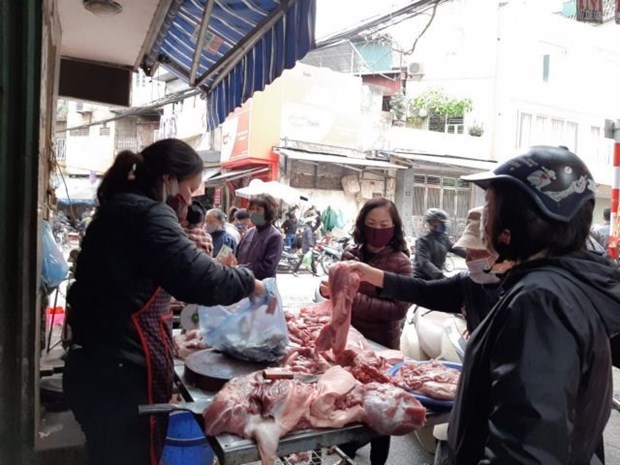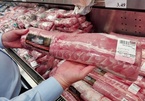 |
|
|
Despite efforts of market management forces and recent large volume of imports, pork prices have continued to increase in recent times despite 15 livestock enterprises pledging to keep prices under 70,000 VND (3 USD) per kilo.
On April 16, live hog prices at farms increased by 2,000-7,000 per kilo to 88,000-92,000 VND in the north.
Especially, Thai Binh province had the highest price of live hogs in the country at 92,000 VND per kilo, 4,000 VND higher than the previous day.
Live hog prices on April 16 surged by 7,000-12,000 VND per kilo to 78,000-88,000 VND in the central region and Central Highlands
Meanwhile, it reached 76,000-87,000 VND per kilo in the south, up 1,000-4,000 VND per kilo compared to the previous day.
The price rose by 2,000 VND per kilo to 91,000 VND in Hanoi and 1,000 VND to 80,000 VND in HCM City, according to vietnambiz.vn.
At present, the price of pork in traditional markets in Hanoi is fluctuating between 150,000-180,000 VND per kilo depending on the cut, an increase of about 11,000 VND per kilo against last week.
According to the Ministry of Industry and Trade, pork is traded in line with market mechanisms. The pork price changes depending on supply and demand, with a supply shortage leading to price increase. Therefore, to stabilise the pork price, the long-term solution is to increase pork supply to meet domestic demand.
To have enough pork supply, Vietnam needs a sustainable domestic industry and to increase pork imports, the ministry said.
The ministry has monitored the domestic pork market, including supply, demand and prices of pork products to propose solutions to stabilise the market.
It has also directed market surveillance forces to enhance control of the pork market to prevent the trading of products with unclear origin.
The ministry has also requested enterprises that have joined the market stabilisation programme to set up plans to stabilise the price.
Meanwhile, the MoIT asked Vietnamese trade offices abroad to seek market information and connect foreign partners to local pork import enterprises.
The ministry also worked with the Ministry of Agriculture and Rural Development (MARD) to diversify resources of imported pork.
The MARD said the high pork price was due to a lack of supply, the high cost of pig rearing due to using bio-safety measures and intermediaries who boost the price.
Nguyen Van Trong, Deputy Director of the MARD’s Department of Livestock Production, said controlling the intermediaries is very difficult as the market lacks production and trading chains.
The MARD has recommended husbandry businesses, especially large firms, build production chains. Those chains would help enterprises and State agencies easily control pork prices.
It has co-operated with relevant ministries and sectors to reduce intermediaries from production to consumption and increase pork imports to meet domestic demand.
The ministry has also suggested local consumers increase their consumption of other kinds of food, he said.
According to the General Statistics Office, in the first quarter of this year, live hog output reached 811,000 tonnes, down 19.3 per cent year-on-year.
The output is expected to surge to 950,000 in the second quarter, one million tonnes in the third quarter and 1.1 million tonnes in the fourth quarter. Thus, by the third quarter, the domestic supply of pork would meet about 90 per cent of pork demand.
Meanwhile, according to the Ministry of Industry and Trade, in the first quarter, Vietnam imported nearly 25,300 tonnes of pork, up 205 per cent year-on-year. VNA

Vietnam imports pork in large quantities
The Ministry of Agriculture and Rural Development (MARD) has done what it promised – imported pork in large quantities from the US, Canada, Brazil and Russia to stabilize the pork market.

Vietnam imports 66,000 tonnes of meat in two months
Vietnam imported nearly 66,000 tonnes of meat in the first two months of this year, according to the Ministry of Agriculture and Rural Development.
 The Ministry of Industry and Trade (MoIT) has said pork must be eligible for price stabilisation due to the high demand for this essential good on the domestic market.
The Ministry of Industry and Trade (MoIT) has said pork must be eligible for price stabilisation due to the high demand for this essential good on the domestic market.